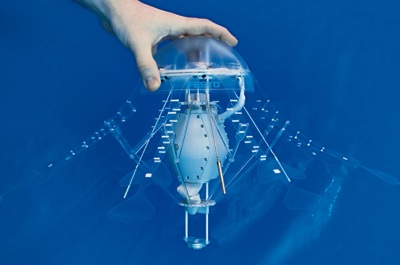Loving Robotic Jellyfish

One one level, these autonomous robotic jelly fish illuminated the mechanism by which real jellyfish swim. Two kinds have been invented: one type that swims in water and one (shown in the video) that swims in air, via a small helium bladder. The parallels in their motions — clearly visible in the video — feel so organic that we immediately assign them life-like adjectives.
I think we are primed to find lifelikeness in machines. E.O. Wilson calls it our biophilia — our intense attraction to living things. As we design machines to approach the complexity of organisms and mimic their behavior (as these do), we will be very quick to include them in our love.
Isn’t it strange we rush to love these bots, but not to the same degree, say, automobile fuel pumps? The pumps are no less complex or capable. These mechanical jellies tell me that when we make artificial intelligences even 1/2 as smart as a dog, we will love it to pieces.
We marvel now at the love some guys have for their cars. This will pale to the strong emotional attachment we should expect to see towards really good automatons. People will cry when they are “turned off.” Not just humanoid robots, but the thousands of other organismal bots that we can and will make.
These robotic jelly fish were built by the “automating technics” company Festo, and displayed at a fair in Hannover. Here are the construction details as reported in Design News by which their graceful conduct is unleashed.
Festo uses an electric drive, geared power transmission and linkages to actuate the tentacles. Alternating tension between the two external surfaces creates a wave-like motion that propels the robots through the water or air. Fischer describes the resulting movement as “peristaltic” since the waving tentacles seem to move by something like muscle contractions.
Whether they swim or fly, these two types of jellyfish steer themselves by carefully controlled weight shifts. As Fischer explains, their bodies contain a servo-driven swash plate connected to a four-armed pendulum that changes their center of gravity. “The pendulum shifts their weight, and they move in a new direction,” he says.
(Thanks, Zander.)


